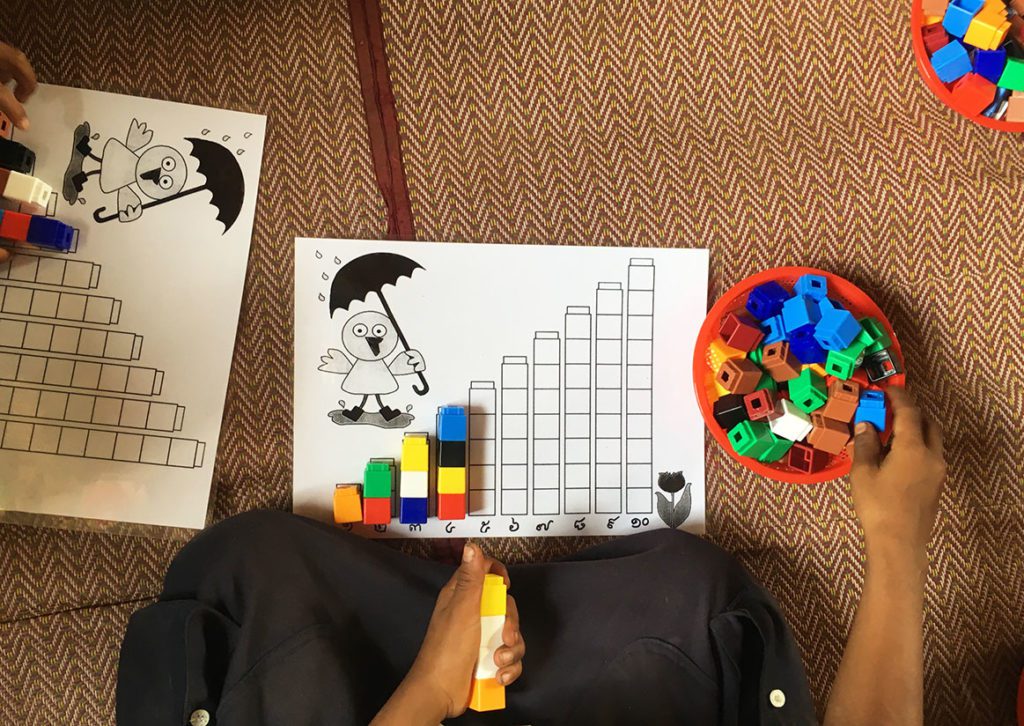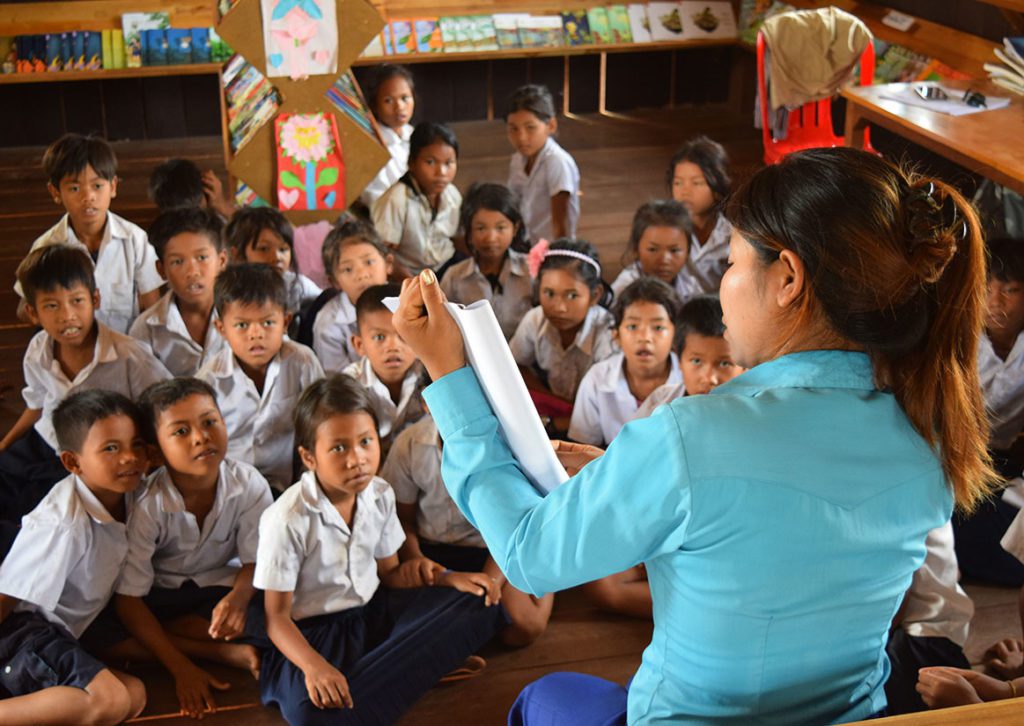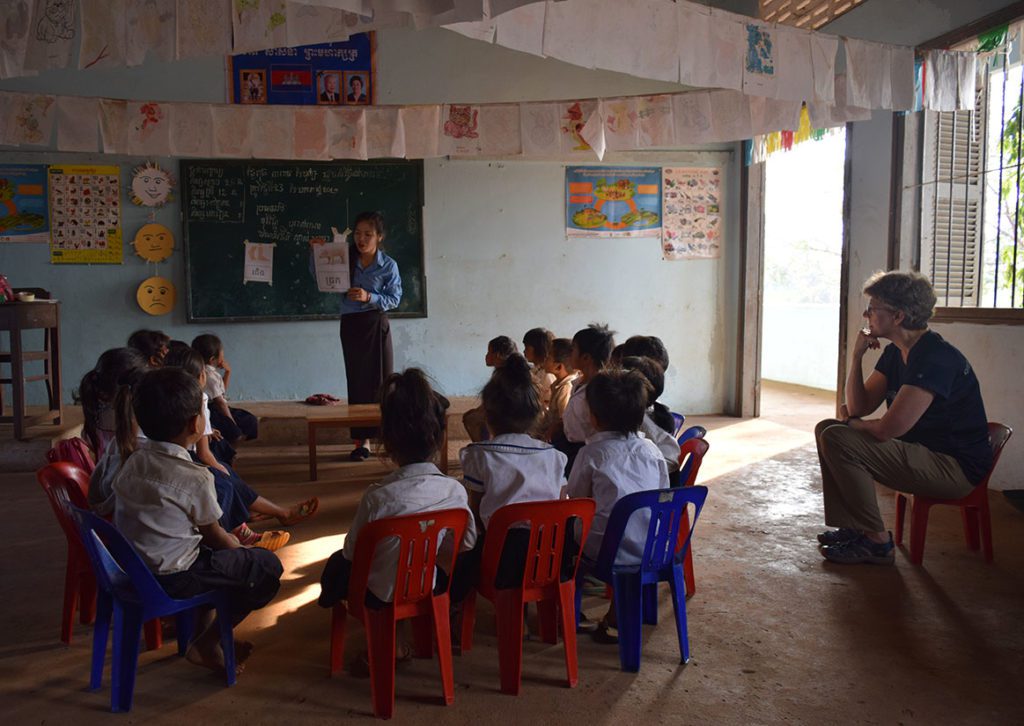Teachers who know what training they need and are asking for it. Read more about our recent teacher trainings!
Over the past year we’ve expanded our Kindergarten and library programs to better suit the needs of our students, and with every brick we lay on the foundation of our programs we stop and think for a moment. Are these changes benefitting our students? How can we refine or improve these additions to maximize our impact? Even more importantly, our teachers are thinking the same thing!
At the beginning of the school year we added an extra-curricular library hour at Koh Ker Primary School, and a few months later we sat down with librarian Sareng to see how things were going. We were thrilled to see a majority of students in all classes coming to the library in their free time, but many of them were more focused on playing educational games than reading. “I’m so happy to see many students coming to the library,” Sareng explained, “but how can I encourage them to read more?”
Our kindergarten teacher at Romchek Primary School picked up on something similar. After spending a week joining classes at the community kindergarten center in Siem Reap, Teacher Sovorn had learned a host of new activities and teaching techniques that she was excited to incorporate into her classroom. But before heading back to Romchek, she raised an important point: “I’m really excited to implement some of the new techniques I learned, but really my first challenge is about getting my students focused enough to learn. How can I spend less time getting everyone in order and more time teaching?”

One Sovorn’s favorite new techniques, using unifix cubes to teach counting!
We heard this feedback and, thanks to the help our teacher training volunteer Pat, we set our plan. We decided to zoom in on interactive reading techniques with Sareng. More than just reading through a book independently, interactive reading is about reading aloud to students and asking open-ended questions to get the wheels spinning in our students’ brains. It’s about bringing engagement to reading for all sorts of learners: the students who speed through a book so fast they forget to look up at the pictures, the students who aren’t confident to read a book by themselves, and the students who aren’t as interested in independent reading. It’s also an enormous challenge for teachers and students who are accustomed to questions of fact, not opinion. Moving beyond “What did the mother say when Tingku returned home?” and “What do you think the mother will say when Tingku arrives home?” takes time and (you guessed it!) training.
With Sovorn, we focused on using positive reinforcement as a tool to manage her kindergarteners. After giving clear instructions to the students, we encouraged Sovorn to walk around the class and point out the students who were following directions. “Bopha is sitting still with her hands on her lap”, “Lyfa is waiting quietly while I write on the board”, and so on. This technique plays on a young child’s need for attention and engagement, refocusing attention to the students who are behaving well rather than the ones who are acting out. It seems simple, but recall that working with a class of twenty wild 3-5 year olds means quite a lot of refocusing.
Now don’t get us wrong, the first attempt wasn’t perfect: on Sareng’s first try she used a prepared worksheet of questions to read and pause to ask a question when prompted. When she reached the first question, she asked the students to discuss in pairs about what other animals they might expect Tingku to run into on his journey. She was met with complete silence. After a few minutes one student cautiously offered up the example of the Owl that Tingku had already met, and everyone waited for Sareng to approve his answer as “correct”.
The first time Sovorn walked around to give the thumbs up to a student following directions, the other students were making so much noise that no one could hear her. She looked up in confusion, having done what we had discussed and seeing no change in student behaviour. There was only one student following her directions, and this limited her ability to draw attention away from everyone else poking their neighbors and twisting each other’s hair.
Moments like these are when one-on-one coaching is critical. There’s a big difference between learning and understanding a new technique and applying it back to your own students! There are many steps in between, and feedback and discussion during those steps is essential to building the confidence to make a new technique your own. For Sareng this involved offering examples to get the students thinking outside the box, centering the students around beginning their responses with the phrase “I think that…”, and most importantly, repetition. In Sovorn’s case we even had to take a step back and work on inserting more games and songs into her lessons to shake out the wiggles before she could settle into a rhythm with lessons. Once established, she was more persistent. She drew attention to that one student who was following her until there were finally two, three, four, ten students sitting quietly. Sareng, Sovorn, Pat, and our field directors worked together for two weeks to practice these new techniques over and over again, reflecting on what worked, what didn’t, and how to tweak and improve each technique step by step.
We took these photos at the end of the second week:

Look at how many students sat down to listen to Sareng (above) read during open hour that day. Look at Sareng’s posture, confident and composed. Look at those mouths drooping open as their attention is captured by the story. Look at those two boys in the bottom left corner soaking it all in!
And will you turn your eyes to the students in Sovorn’s classroom (below) who are all looking directly at her while she instructs? Even Pat put away her notebook for the day to watch Sovorn teach! We wish we could play an audio for this picture to share with you just how quiet and calm it was once the students realized that only the ones following directions would get the attention they wanted. Seriously, do you see those hands on those laps?!

We are so proud to stand together with our teachers in a constant effort to bring new ideas and techniques into the the classroom. Supporting teachers is right there in our mission statement: promoting access to quality education for children and youth. Breaking down the barriers of access to education is a critical first step, but it’s only the first step. Once that student walks into the classroom, how can we ensure that their education is high quality?
Our answer: high quality teachers.
We’re talking teachers who are well-trained, equipped with the classroom resources they need, and are earning a wage that allows them to focus on their work and support themselves financially. Join us in turning your focus to high quality education by designating a donation to our Teacher Support program here, or bring your teacher training skills to the table by joining us as a volunteer!
Koh Ker and Romchek primary schools are projects of PLF Canada, executed by PLF Cambodia.

Recent Comments